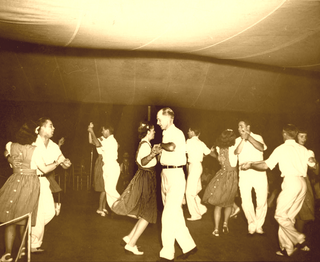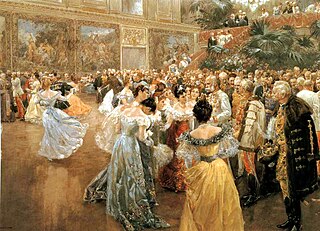
Ballroom dance is a set of European partner dances, which are enjoyed both socially and competitively around the world, mostly because of its performance and entertainment aspects. Ballroom dancing is also widely enjoyed on stage, film, and television.

Renaissance dances belong to the broad group of historical dances, specifically those during the Renaissance period. During that period, there was a distinction between country dances and court dances. Court dances required the dancers to be trained and were often for display and entertainment, whereas country dances could be attempted by anyone. At Court, the formal entertainment would often be followed by many hours of country dances which all present could join in. Dances described as country dances such as Chiarantana or Chiaranzana remained popular over a long period – over two centuries in the case of this dance. A Renaissance dance can be likened to a ball.

Regency dance is the term for historical dances of the period ranging roughly from 1790 to 1825. Some feel that the popular use of the term "Regency dance" is not technically correct, as the actual English Regency lasted only from 1811 until 1820. However, the term "Regency" has been used to refer to a much broader period than the historical Regency for a very long time, particularly in areas such as the history of art and architecture, literature, and clothing. This is because there are consistencies of style over this period which make having a single term useful.

The waltz, meaning "to roll or revolve") is a ballroom and folk dance, normally in triple, performed primarily in closed position.

A country dance is any of a very large number of social dances of a type that originated in the British Isles; it is the repeated execution of a predefined sequence of figures, carefully designed to fit a fixed length of music, performed by a group of people, usually in couples, in one or more sets. The figures involve interaction with your partner and/or with other dancers, usually with a progression so that you dance with everyone in your set. It is common in modern times to have a "caller" who teaches the dance and then calls the figures as you dance. Country dances are done in many different styles.

A square dance is a dance for four couples, or eight dancers in total, arranged in a square, with one couple on each side, facing the middle of the square. Square dances are part of a broad spectrum of dances known by various names: country dances, traditional dances, folk dances, barn dances, ceilidh dances, contra dances, Playford dances, etc. These dances appear in over 100 different formations, of which the Square and the Longways Set are by far the most popular formations.

Social dances are dances that have social functions and context. Social dances are intended for participation rather than performance. They are often danced merely to socialise and for entertainment, though they may have ceremonial, competitive and erotic functions.

The history of dance is difficult to access because dance does not often leave behind clearly identifiable physical artifacts that last over millennia, such as stone tools, hunting implements or cave paintings. It is not possible to identify with exact precision when dance becomes part of human culture. Dance is filled with aesthetic values, making it distinct from one society to another and is shrouded in symbolism that expounds on the cultural heritage of a community accordingly being unique from one society to another. Dance can help tell a story, convey feelings and emotions, and connect with others and ourselves.

Historical dance is a term covering a wide variety of Western European-based dance types from the past as they are danced in the present. Today historical dances are danced as performance, for pleasure at themed balls or dance clubs, as historical reenactment, or for musicological or historical research.
The music of Grenada has included the work of several major musicians, including Eddie Bullen, David Emmanuel, one of the best-selling reggae performers ever, and Mighty Sparrow, a calypsonian. The island is also known for jazz, most notably including Eddie Bullen, a pianist, songwriter and record producer currently residing in Canada. Kingsley Etienne, a keyboardist, while the Grenadan-American Joe Country & the Islanders have made a name in country music.

A ball is a formal dance event often characterised by a banquet followed by a social dancing. Ball dancing emerged from formal dances during the Middle Ages and carried on through different iterations throughout succeeding centuries, such as the 17th century Baroque dance and the 18th century cotillion. Several variations exists such as the masquerade and debutante ball as well as the more modern prom.

Sequence dancing is a form of dance in which a preset pattern of movements is followed, usually to music which is also predetermined. Sequence dancing may include dances of many different styles. The term may include ballroom dances which move round the floor as well as line, square and circle dances.

The cotillion is a social dance, popular in 18th-century Europe and North America. Originally for four couples in square formation, it was a courtly version of an English country dance, the forerunner of the quadrille and, in the United States, the square dance.

African-American dance is a form of dance that was created by Africans in the Diaspora, specifically the United States. It has developed within various spaces throughout African-American communities in the United States, rather than studios, schools, or companies. These dances are usually centered on folk and social dance practice, though performance dance often supplies complementary aspects to this. Placing great value on improvisation, these dances are characterized by ongoing change and development. There are a number of notable African-American modern dance companies using African-American cultural dance as an inspiration, among these are the Whitey's Lindy Hoppers, Alvin Ailey American Dance Theater, Dance Theatre of Harlem, and Katherine Dunham Company. Hollywood and Broadway have also provided opportunities for African-American artists to share their work and for the public to support them.

The first dance is an element in a number of traditions, being an opening of a certain dance function: ball, prom, wedding, etc.
Quadrille Ball is an annual society ball that has taken place in New York City each year since 1961, usually in January or February. It is a non-profit event that benefits the Germanistic Society, which in turn awards scholarships for the exchange of American and German graduate and undergraduate students. The event is normally held at The Pierre in Manhattan.

The Ballroom scene is an African-American and Latino underground LGBTQ+ subculture. Its origins can be found in drag balls of the mid-19th century United States, such as those hosted by William Dorsey Swann, a formerly enslaved Black man in Washington D.C.. By the early 20th century, integrated drag balls were popular in cities such as New York, Chicago, New Orleans, Baltimore, and Philadelphia. In the mid-20th century, as a response to racism in integrated drag spaces, the balls evolved into house ballroom, where Black and Latino attendees could "walk" in a variety of categories for trophies and cash prizes. Most participants in ballroom belong to groups known as "houses," where chosen families of friends form relationships and communities separate from their families of origin, from which they may be estranged. The influence of ballroom culture can be seen in dance, language, music, and popular culture, and the community still exists today.

The Bradley-Martin Ball was a lavish costume ball at the Waldorf Hotel in New York City on the night of February 10, 1897. Cornelia Bradley-Martin, wife of Bradley Martin, organized the ball. Eight hundred socialites spent about $400,000 imitating kings and queens. Bradley-Martin's stated intention was to create an economic stimulus for New York City, which was at the end of the Long Depression which began in 1873 and included the Panic of 1893. The Bradley-Martins spent approximately $9.7 million in today's money to throw the ball. Across the country, preachers and editorial writers argued over the propriety of a party that would cost hundreds of thousands of dollars. In the end, the ball was a social triumph but created negative publicity.
Steven Mithen, is an archaeologist. He is noted for his work on the evolution of language, music and intelligence, prehistoric hunter-gatherers, and the origins of farming. He is professor of early prehistory at the University of Reading.
European dances refers to various dances originating in Europe. Since Medieval ages, many European dances tend to be refined, as some are based on the court dances of aristocrats.
















